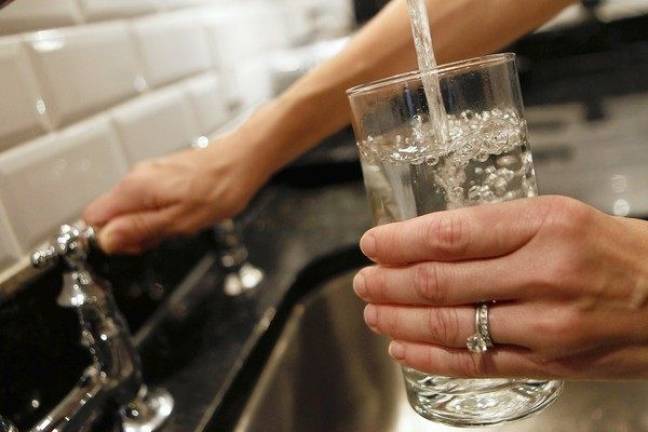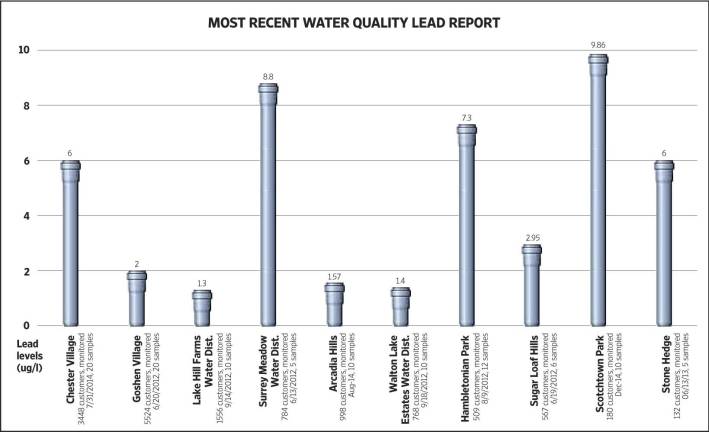How much lead is in your water?


By Erika Norton
GOSHEN — With the recent exposure of elevated lead levels in the Flint, Michigan public water systems, many are wondering how much lead is in their water.
“I don’t think we have a Midwest situation here, for sure,” said Chris Ericson, deputy commissioner for the Orange County Department of Health. “And everything is monitored here. We comply with federal and state regulations and any place that has exceeded the maximum contamination limit, we are aware of those and we will be working with them… (but) we don’t have that same situation out here, for sure.”
The Environmental Protection Agency requires that all community water systems prepare and deliver an annual water quality report called a Consumer Confidence Report (CCR) for their customers by July 1 of each year. The goal of these reports is to provide educational material, allowing consumers to make educated decisions regarding any potential health risks pertaining to the quality, treatment and management of their drinking water supply.
Information found on these reports includes testing for microbiological contaminants like E. coli, radioactive contaminants, synthetic organic contaminants including pesticides and herbicides, volatile organic contaminants found in discharge from chemical factories, and inorganic contaminants like copper, mercury and lead. Some states, like Pennsylvania and New Jersey, require these test results to be posted on their Department of Health website, but not New York State.
The highest level of lead was found in the Scotchtown Park water system in Goshen, with 9.86 ug/L, which is still relatively low. The lowest level was found by the Lake Hill Farms water district, with 1.3 ug/L.
As explained within the Consumer Confidence Reports, the two main ways lead gets into water is by the corrosion of household plumbing systems and the erosion of natural deposits. Overall, Orange County hasn’t had a problem with elevated lead levels in drinking water in recent years, according to Lee Bergus, senior public health engineer for the Orange County Department of Health Division of Environmental Health.
Bergus said that when the law banning all lead-based plumbing changed in the late 80s, not all water systems were in compliance, however most systems have since implemented corrosion control programs.
“The areas that we we’re most concerned were the homes that were built between 1982 and 1986,” Bergus said, which is five years before the ban on lead solder when into effect in 1986, because those homes may have had lead service pipes.
“Those were the most potentially at risk homes, and then progressively down from the there, were the homes older than ‘82, which would be less if a risk actually because there was more time for the mineralization of the pipes to coat the pipes and to prevent the contact of the water with the lead solder or brass.”
According to the EPA, homes built before 1986 have a higher likelihood of having lead pipes, fixtures and solder. Bergus said that the amount of older homes varies from municipality to municipality and a lot of growth has been going on between when the lead rules started and now.
Nevertheless, some of the older communities such as Port Jervis, Middletown, Newburgh and Walden are the types of areas that will traditionally have more older homes, Bergus said.
The generally recommended testing includes a standard bacteria test for the total coliform/E. Coli and a nitrate test. If the well owner has young children, including a lead test is recommended, according to the OCDOH.
Other possible contaminants include volatile organics (including petroleum products and solvents), sodium, chloride, and naturally occurring radiological deposits such as radon, radium and uranium. The OCDOH also says that the vulnerability of the well to contamination often depends on the depth of the well, proper well construction and the proximity to potential sources of contamination, which are considered by local building departments and health departments prior to approving new well locations.
Water directly from wells in Orange County generally does not have detectable levels of lead; however, corrosion from the internal plumbing can result in elevated levels of lead or other metals in the water at the tap, the OCDOH says. Any testing and suggested treatment should come from a New York State Department of Health certified lab.
The EPA also says that lead can accumulate in our bodies over time, where it is stored in bones along with calcium. During pregnancy, lead is released from bones as maternal calcium and is used to help form the bones of the fetus, especially in women with not enough calcium in their diet.
Lead can also cross the placental barrier exposing the fetus the lead, according to the EPA. This can result in serious effects to the mother and her developing fetus, including reduced growth of the fetus and premature birth.
The EPA also adds that adults who drink this water over many years could develop kidney problems or high blood pressure.
The Centers for Disease Control and Prevention, along with individual state’s departments of health, collect childhood blood lead surveillance data for children under three years of age. In addition, New York State law requires all children be tested at one and two years of age. If a child is tested and is found to have equal to or more than 10 ug/dL of lead in their blood, they are considered to have an elevated blood lead level.
According to the CDC, New York State, excluding New York City, had the highest percentage of children under three with an elevated blood lead level in 2014, with 1.46 percent statewide. The second highest state was Pennsylvania, with 1.28 percent statewide.
Only 1.0 percent of the children tested had an elevated blood lead level in Orange County in 2014, with the highest counties being Oneida and Allegany Counties. According to Ericson, elevated blood lead levels in children has been a “pretty good issue” in Orange County for many years, but the main source of lead in the area is paint.
“I would say that we have probably one of the higher levels of lead in children in the state typically with regard to lead paint in housing,” he said.
To combat high blood lead levels, Ericson said that the OCDOH has had Childhood Lead Poisoning Prevention programs for quite a few years, which encourage parents to have their children tested for lead and conduct investigations in their houses when children do have lead poisoning.
The problem they run into is that in order to know whether a child has an elevated blood lead level, they have to be tested, and even though it is required by state law, that doesn’t always happen in some areas, according to Ericson.
“There are some areas in the county that are definitely more proactive in having their children tested than in other areas,” Ericson said. “And we would typically find those in the three city areas of the county - Newburgh, Middletown and Port Jervis - with Newburgh probably being the highest. That’s because the kids in those areas are probably tested more accurately, or more frequently, than maybe some in the outlying areas.”
He also said the housing stock in the city of Newburgh is old and some of the areas are not as well maintained as other areas. A poor building condition may be more conducive to lead poisoning, according to Ericson.
One way parents can be proactive in preventing lead poisoning is to have their child properly screened by their pediatrician, having their blood drawn at the appropriate times, according to Ericson. It’s also good to be aware of the age of the building they live in, because the pre-1970s are most likely to have lead paint.
“If they do see chipping or flaking paint, they should get that repainted quickly because paint today does not have any lead in it,” Ericson said. “So if we can keep the paint layers stable, we’re going to keep the children a little bit more safe just by doing that.”
The New York State Department of Health also has a list of recommendations, including using only cold tap water to prepare formula, for drinking and cooking because water that comes out of the tap warm or hot can contain much higher levels of lead, and boiling water will not reduce the amount of lead.
For more information on lead in drinking water, contact the NYSDOH Environmental Health Infoline at 1-800-458-1158 or the EPA Safe Drinking Water Hotline at 1-800-426-4791.